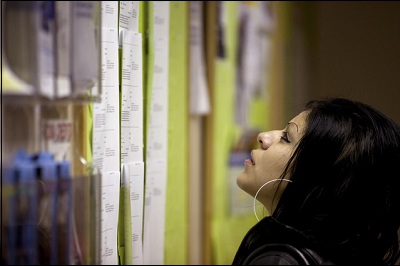
|
|

|
|
| April 25, 2024 |
|
Jobless claims in U.S. fell more than forecast last week 
Claims for jobless benefits plunged last week, showing U.S. employers have little need to trim staff as demand improves.
Applications for unemployment insurance payments decreased by 27,000 to 341,000 in the week ended Feb. 9, fewer than any of the 49 economists surveyed by Bloomberg projected, according to Labor Department data issued Thursday in Washington. Another report showed consumer sentiment last week climbed to the highest level in a month. A drop in firings will probably help workers feel more secure in their jobs, which, combined with a housing-market rebound and rising stock prices, may bolster consumer confidence and in turn spending. Sustained pickups in hiring and incomes would ensure that households have the means to overcome the burden of a higher payroll tax. “The labor market is improving, but only at a very steady pace,” said Yelena Shulyatyeva, a U.S. economist at BNP Paribas in New York, who had the lowest forecast in the Bloomberg survey. “What we need is an acceleration in hiring to move the unemployment rate lower.” The Bloomberg Consumer Comfort Index rose to minus 35.9 in the period ended Feb. 10 from minus 36.3 in the prior week, another report showed. The gauge advanced for a second consecutive week, led by waning pessimism about the economy. Shares were little changed as the drop in claims tempered concern over disappointing economic data from overseas. The Standard & Poor’s 500 Index rose less than 0.1 percent to 1,521.12 at 10:52 a.m. in New York after reports showed economies in Europe and Japan shrank more than forecast in the fourth quarter. A U.S. Labor Department spokesman said the agency estimated claims for two states last week, Connecticut and Illinois. Subsequent data obtained from Connecticut were close to the estimates, the spokesman said, an indication the reading was accurate. Projections in the Bloomberg survey ranged from 350,000 to 375,000 claims. The Labor Department revised the previous week’s figure to 368,000 from a previously reported 366,000. Drop ‘Legitimate’ “It does seem to feel that the recent downward move in claims is legitimate,” Jill Brown, an economist at Credit Suisse in New York, said in a research note. “2013 has had three weeks so far below the 350K mark, and we’re only six weeks into the year. 2012 had only two weeks below 350K the entire year. Have to go back to early 2008 and all of 2007 to see sub- 350K prints sustained.” The four-week moving average, a less volatile measure than the weekly figures, rose to 352,500 last week from an almost five-year low of 351,000 the prior period. Employers added 157,000 workers to payrolls in January after hiring a revised 196,000 the month before, and the unemployment rate climbed to 7.9 percent, Labor Department figures showed Feb. 1. The average duration of unemployment fell in January to 35.3 weeks, the lowest since December 2010, from 38.1 weeks a month earlier, according to the data. Retail sales Figures yesterday showed the brighter labor picture is helping underpin spending. Retail sales rose 0.1 percent in January after 0.5 percent increases in each of the prior two months, according to the Commerce Department. Netgear Inc. Chief Executive Officer Patrick C. S. Lo said Feb. 12 that household spending is on the mend. The gauge in the Bloomberg Consumer Comfort Index assessing Americans’ views on the current state of the economy improved for a third straight week, today’s report showed. The measure of personal finances held at the highest level this year, while the buying climate index fell to the lowest point in more than four months. Gasoline costs Higher fuel costs may be to blame for the decline in the purchasing outlook. The price of a gallon of regular gasoline has climbed about 40 cents since last year’s low of $3.22 reached on Dec. 19, according to date from AAA, the largest U.S. motoring organization. What’s more, workers are smarting from the increase in the payroll tax, which Congress allowed to return to its 2010 level of 6.2 percent from 4.2 percent. An American who earns $50,000 is taking home about $83 less a month because of the levy. Nonetheless, housing and equity gains are probably taking up some of the slack. Prices for single-family homes climbed in almost 88 percent of U.S. cities in the fourth quarter as the housing recovery broadened, a report from the National Association of Realtors showed this week. The national median price for a home was $178,900 in the fourth quarter, up 10 percent from the same period in 2011. That was the biggest gain since 2005, according to the Realtors group. (Source: Bloomberg) Story Date: February 15, 2013
|